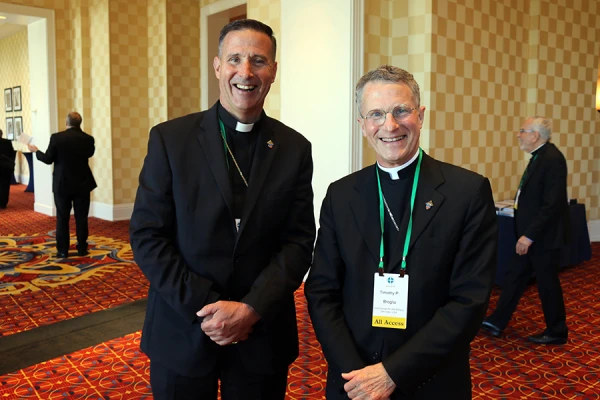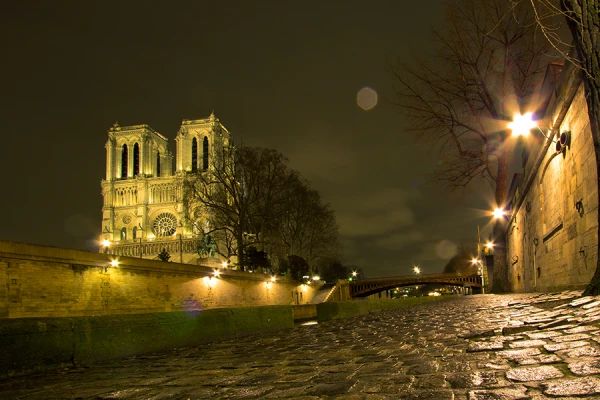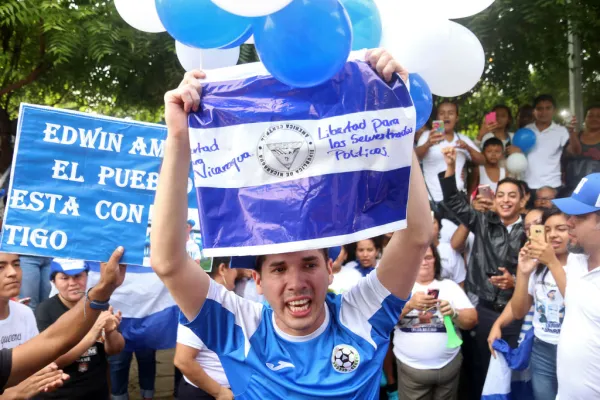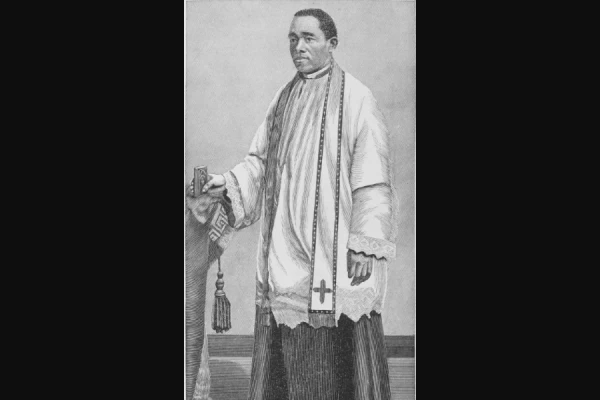
Baltimore, Md., Jun 12, 2019 / 03:48 pm (CNA).- At the US Conference of Catholic Bishops’ biannual assemblies, new members of the US episcopate are announced, to much applause. CNA spoke to the newest members of the USCCB to find out what it’s like to be the new kid on the block.
Two of this year’s newcomers, Bishops William Muhm and Joseph Coffey have much in common. They have both served in the Navy, both as chaplains and prior to entering seminary; both were announced as the auxiliary bishops of the Archdiocese for the Military Services Jan. 22; and both were consecrated March 25. Neither expected to be bishops.
This is the first time either of them have attended a USCCB general assembly, and they told CNA they were a little bit intimidated at first by some of their brother bishops.
Bishop Coffey said that he did not anticipate speaking up much during this assembly, and that “as a new guy, I’m going to do a lot of observing.” Coffey was chosen to be one of the tellers of the assembly, an administrative duty that means he will be verifying the vote totals of the elections. He told CNA that he suspects he was chosen for this role because he is a brand new bishop.
Mild episcopal hazing aside, Coffey said that “it’s pretty darn exciting” to be at the general assembly and to be sitting next to the men he has read about and admired for years. He said he felt as though he has joined an “incredibly warm and friendly and welcoming community of brothers.”
Coffey said that as a bishop, he has been given the chance to represent Archbishop Timothy Broglio at events, and has traveled around the country with the permission of the military. As he is still active duty in the Navy, he said he will be seeking retirement or entering the reserves in order to work full-time as a bishop.
The whole experience, said Coffey, has been surreal.
“I was not expecting this at all, and so, it has only been a couple of months, so I’m still getting used to God’s providence and how it’s really changed my life, but it’s exciting, to say ‘yes’ and see what happens,” he said.
Bishop Muhm likened the feeling to the first day of school, but said that “everyone’s been really welcoming.” He relished the chance to get to know the other bishops and to develop fraternal bonds, which he said was “one of the most important reasons to be here.”
Like Coffey, Muhm also said he planned on “doing a lot more listening than talking”, and that he was adjusting to the nuances associated with the bishops’ conference. With his primary priestly experience as a military chaplain, and only about six weeks administering a parish prior to being appointed a bishop, Muhm’s ecclesiastical career has been very different from most of his brother bishops.
“It’s been a little bit overwhelming, with the level of detail that’s being discussed,” said Muhm. “I don’t have a background in many of these things that they’re talking about, and I hadn’t seen the documents until recently.”
Muhm told CNA that he has been enjoying his time at the general assembly nevertheless, and is excited to move forward with his duties as bishop, which will involve tending to the needs of Catholics in the military serving in Asia and Europe.
Bishop Alex Aclan, an auxiliary bishop of the Archdiocese of Los Angeles, was driving when he received a call from the nuncio Feb. 17. Aclan, who was on a sabbatical at the time, said that he was “pretty calm” when he found out his new role, and that he had “really no strong emotions.”
As the Archdiocese of Los Angeles is home to about 11.6 million people, with about 4.3 million Catholics, the auxiliary bishops are assigned to regions. Aclan is assigned to the San Fernando region, which includes 55 parishes, 13 high schools, and three hospitals. He said he has had a chance to visit a little less than half of the parishes so far, and that he has been very busy.
Aclan told CNA that he has been warmly received by the other bishops, who are “very welcoming” and “very hospitable, you know, when they see that you look lost.”
“They walk up to you and they’re talking to you, so they’re very really nice,” he said with a laugh.
While Aclan may be new to the USCCB, his prior role as the Vicar for Clergy for Losg Angeles archdiocese meant that he was already familiar with some of the bishops, and was not entirely alone at his first general assembly.
“Some of the bishops actually attended the conferences that we had (for other Vicars for Clergy), and some of those Vicars for Clergy now have also become bishops themselves,” he said.
While Bishops Aclan, Coffey, and Muhm are all newly consecrated, Archbishop Borys Gudziak was consecrated nearly seven years ago. Gudziak was installed June 4 as head of the Ukrainian Archeparchy of Philadelphia. Prior to that, he was Bishop of the Ukrainian Eparchy of Saint Vladimir the Great of Paris, and thus a member of the French bishops’ conference. The spring meeting marked the first time he has attended a USCCB general assembly.
Gudziak said that transitioning from a European eparchy to an American archeparchy was an adjustment, and that the Ukrainian Catholic population in the United States is substantially different than that of Europe. His past eparchy included five western European countries, and the war in Ukraine has resulted in an influx of very poor, often undocumented, Ukrainian emigrants moving to the European Union.
For Gudziak, his time in Paris “wasn’t a place or position or a job, it really became a family.” So when he when he was asked to come to America, it was “mixed emotions.”
He said he felt “sadness of leaving family members whom we went through thin and thin, I would say, not thin and thick. But great joy at coming back home,” he said. Gudziak was born and raised in the United States.
Comparatively, the Ukrainian Catholics in the United States have “about 70 years more history” than their western European counterparts, as well as “much more infrastructure.”
“The number of churches, schools, facilities, that are archeparchy here I would say has 50-70 times as much as we had in France,” said Gudziak.
Despite this, Gudziak said that his new parishioners face many of the same issues as his older ones, particularly among young people.
“With the young generation, there’s a need for coming down as Jesus came down and meeting people heart to heart,” he said. “Or as one young person had told me, ‘I need to be met at my broken heart.’”
The Ukrainian Catholic Church is one of the 23 Eastern Catholic Churches. And although he is not a Latin rite bishop like the majority of the bishops in the USCCB, Gudziak said that his new brother bishops have been “particularly friendly, knowledgeable, and embracing.”
And while he declined, citing his relative newness, specifically to say how he planned on using his unique experience to help the USCCB, Gudziak told CNA that he thinks he can play a role in improving relations between the Church in the US and Churches around the world.
“One thing that I would like to witness to is the universality of the Church,” said Gudziak. He said that due to the lack of American priests and seminarians who study in other countries, “it’s becoming more difficult to keep a knowledgeable, friendly relationship with other episcopal conferences and other bishops.”
“And I hope that I can contribute to a friendship between the Church in the U.S. and the Church in Western and Eastern Europe,” said Gudziak, “since I lived in both parts of that continent for many years.”
 […]
[…]








